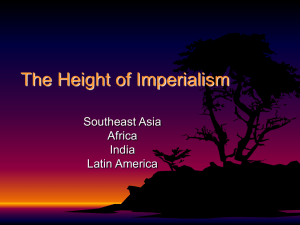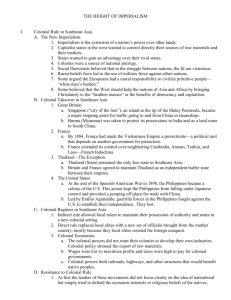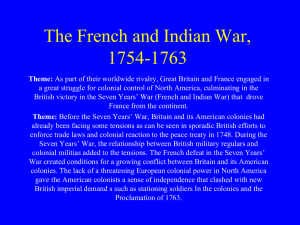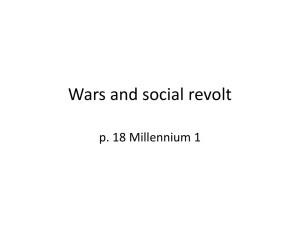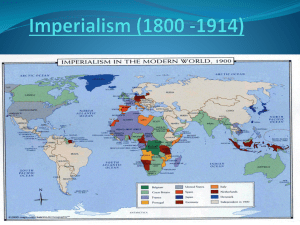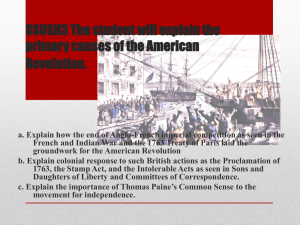Imperialism Notes - Glasgow Independent Schools
advertisement
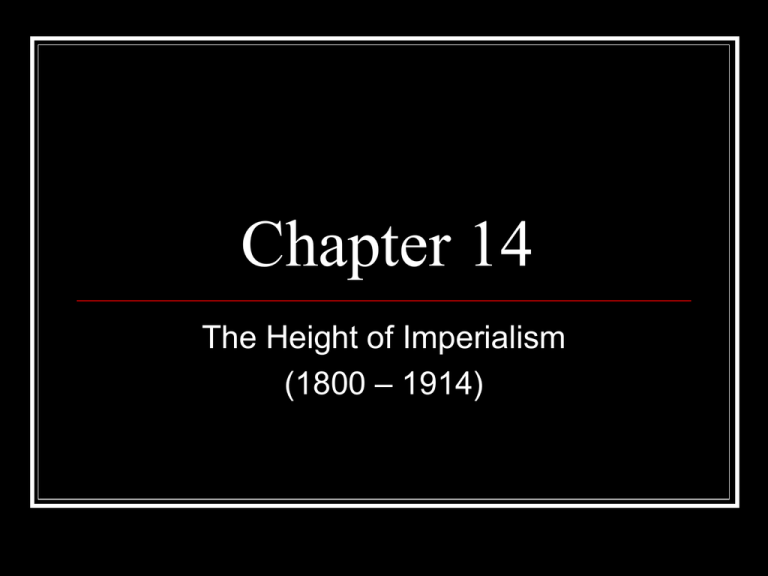
Chapter 14 The Height of Imperialism (1800 – 1914) Section 1: Colonial Rule in Southeast Asia Western expansion into Asia and Africa Source of industrial raw materials Market for Western manufactured goods Source of national prestige Moral responsibility to civilize the primitive people convert them to Christianity and introduce them to the benefits of Western democracy and capitalism Great Britain Founded a new colony on the Malay Peninsula called Singapore Took control of Burma (known as Myanmar today) France Sent missionaries to Vietnam Internal rivalries divided the country into two separate governments Territory became a French protectorate Thailand Only remaining free state in Southeast Asia Two remarkable rulers resisted Western expansion into their territory by maintaining friendly relations with the major powers King Mongkut King Chulalongkorn Would become a buffer state between the possessions of Britain and France in Southeast Asia Indirect and Direct Rule Indirect rule allowed local rulers to maintain their positions of authority while they carried out the laws of imperial country Lowered the cost of government Had a less effect on the local culture Direct rule Local elites were removed from power and replaced with a new set of officials from the mother country Colonial economies Because colonial powers didn’t want the colonists to develop their own industries Colonial policy dictated the export of raw materials It also led to the formation of plantation agriculture owned by foreign investors Positive note: they built railroads, highways, etc. that benefitted the local people Resistance to Colonial Rule Many were unhappy with Western rule Original resistance came from the ruling class Resistance would eventually lead to peasant revolts A new urban middle class that was educated in Western style schools would eventually lead massive resistance movements in their countries This would not happen until the 1930’s **end of notes** Section 2: Empire Building in Africa By 1900, virtually all of Africa was under European rule. As the slave trade declined in West Africa, Great Britain and France would establish territories in the interest of peanuts, timber, hides, and palm oil. By 1890’s, slavery had been abolished in all major countries of the world. North Africa Muhammad Ali seized power from the Ottoman Turks and established Egypt as a separate state. He modernized the army, set up a public school system, and created small industries. British became interested in building a canal to connect the Med. Sea to the Red Sea. Suez Canal was completed in 1869. Egypt would become a British protectorate in 1914. Central Africa David Livingstone explored parts of Central Africa for 30 years. When he disappeared, Henry Stanley (a journalist) went in search of him. He continued Livingstone’s work when he died in 1873. South Africa Afrikaners (a.k.a. the Boers), were forced northward when the British seized Cape Town and the surrounding areas in South Africa. As a result, many natives were put on reservations as the Boers moved northward. Boers were in constant battle with the Zulu. Eventually the British would defeat the Zulu. Rise of Nationalism A new class of leaders emerged as a result of their education in the West. Many of them came to resent foreigners because it meant a loss of their farmlands as well as loss of jobs on plantations and factories. Westerners segregated schools, churches, clubs, etc. They would eventually organize political parties and movements to seek an end to foreign rule. **end of notes** Section 3: British Rule in India British East India Company Interfered in India’s political and military affairs Employed Indian soldiers known as sepoys They would later revolt because: of distrust of the British A rumor that the British were using bullets greased with pig and cow fat Revolt was crushed within a year Because of the revolt, the British tightened their control in India. Positive effects: Brought order and stability to the region School system created Railroads, telegraph, and postal system created Negative effects: British manufactured goods destroyed the local industries Increased taxes Loss of farmland Shortage of food supply because of new farm product – cotton Disrespect for Indian culture Indian Nationalist Movement In 1885, a group met in Mumbai and created the Indian National Congress Goal was to seek India’s independence from British control In 1915, an individual by the name of Mohandas Gandhi would set up a movement of non-violent resistance. His actions would eventually lead to India’s independence. **end of notes** Section 4: Nation Building in Latin America The successful revolution in North America led to the beginning of revolts in Latin America. Creoles supported legal equality of all people as well as free trade and free press. They soon denounced the rule of the Spanish and the Portuguese. Revolt in Mexico Miguel Hidalgo roused the local natives and mestizos to free themselves from Spain. Sept. 16, 1810, a mob attacked the Spaniards. Their revolt would be crushed and Hidalgo sentenced to death. Under Agustin de Iturbide, the Mexicans would declare their independence in 1821. Revolts in South America Jose de San Martin and Simon Bolivar led revolutions throughout South America. The Central American states would be free by 1823. (Guatemala, El Salvador, Honduras, Costa Rica, and Nicaragua) By the end of 1824, Peru, Uruguay, Paraguay, Colombia, Venezuela, Argentina, Bolivia, and Chile would be freed from Spain. Problems with Nation Building Rule of Caudillos New imperialism Ruled by military force British investors poured money into industries Inequality The elite maintained most of the power The United States in Latin America Cuba became a protectorate Costa Rica was annexed Supported Panama in a rebellion to separate from Colombia and become its own nation In return, the U.S. was given control of 10 miles of land running from coast to coast – they built the Panama Canal which opened in 1914 **end of notes**

